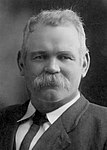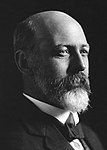1910 Australian Senate election
| |||||||||||||||||||||||||||||||||||||
18 of the 36 seats in the Senate 18 seats needed for a majority | |||||||||||||||||||||||||||||||||||||
|---|---|---|---|---|---|---|---|---|---|---|---|---|---|---|---|---|---|---|---|---|---|---|---|---|---|---|---|---|---|---|---|---|---|---|---|---|---|
| |||||||||||||||||||||||||||||||||||||
The Australian states each elected three members of the Australian Senate at the 1910 federal election to serve a six-year term starting on 1 July 1910.
Australia
[edit]| Party | Votes | % | Swing | Seats won | Seats held | Change | |
|---|---|---|---|---|---|---|---|
| Labour | 2,021,090 | 50.30 | +11.57 | 18 | 22 | ||
| Liberal | 1,830,353 | 45.55 | −11.25 [a] | 0 | 14 | ||
| Independents | 134,976 | 3.36 | +2.46 | 0 | 0 | ||
| Socialist Labor | 31,700 | 0.79 | −0.51 | ||||
| Total | 4,018,119 | 18 | 36 | ||||
| Invalid/blank votes | 62,700 [b] | 4.66 | –1.7 | ||||
| Turnout | 1,402,106 | 62.08 | |||||
| Registered voters | 2,258,482 | ||||||
| Source: Psephos: 1910 Senate | |||||||
New South Wales
[edit]Each elector voted for up to three candidates. Percentages refer to the number of voters rather than the number of votes.
| Party | Candidate | Votes | % | ±% | |
|---|---|---|---|---|---|
| Labour | Allan McDougall (elected 1) | 249,212 | 51.0 | ||
| Labour | Albert Gardiner (elected 2) | 247,047 | 50.6 | +8.9 [c] | |
| Labour | Arthur Rae (elected 3) | 239,307 | 49.0 | ||
| Liberal | John Gray (defeated) | 214,889 | 44.0 | −15.2 [d] | |
| Liberal | Edward Pulsford (defeated) | 212,150 | 44.0 | −17.0 [d] | |
| Liberal | John Neild (defeated) | 212,150 | 43.4 | −18.2 [d] | |
| Independent | John Norton | 50,893 | 10.4 | ||
| Socialist Labor | Robert Mackenzie | 13,608 | 2.8 | ||
| Socialist Labor | James Moroney | 9,660 | 2.0 | −6.3 [c] | |
| Socialist Labor | Thomas Hoare | 8,432 | 1.7 | ||
| Total formal votes | 1,465,767 488,589 voters |
95.3 | +2.6 | ||
| Informal votes | 24,213 | 4.7 | −2.6 | ||
| Turnout | 512,802 | 61.4 | +9.7 | ||
| Party total votes | |||||
| Labour | 735,566 | 50.5 | +9.2 | ||
| Liberal | 647,608 | 44.4 | −10.8 [e] | ||
| Independent | 50,893 | 3.5 | |||
| Socialist Labor | 23,268 | 1.6 | −1.8 | ||
Queensland
[edit]Each elector voted for up to three candidates. Percentages refer to the number of voters rather than the number of votes.
| Party | Candidate | Votes | % | ±% | |
|---|---|---|---|---|---|
| Labour | Thomas Givens (re-elected 1) | 82,234 | 50.8 | −1.0 [d] | |
| Labour | Harry Turley (re-elected 2) | 81,719 | 50.5 | −4.6 [d] | |
| Labour | James Stewart (re-elected 3) | 80,339 | 49.7 | −3.8 [d] | |
| Liberal | Thomas Glassey | 77,895 | 48.1 | ||
| Liberal | Hugh Macrossan | 77,367 | 47.8 | ||
| Liberal | Joe Millican | 75,707 | 46.8 | ||
| Independent | William Kellett | 6,065 | 3.7 | ||
| Independent | Horace Ransome | 4,014 | 2.5 | ||
| Total formal votes | 485,340 161,780 voters |
94.8 | +0.7 | ||
| Informal votes | 8,854 | 5.2 | −0.7 | ||
| Turnout | 170,634 | 61.2 | +15.3 | ||
| Party total votes | |||||
| Labour | 244,292 | 50.3 | +8.3 | ||
| Liberal | 230,969 | 47.6 | −2.8 [f] | ||
| Independent | 10,079 | 2.1 | |||
South Australia
[edit]Each elector voted for up to three candidates. Percentages refer to the number of voters rather than the number of votes.
| Party | Candidate | Votes | % | ±% | |
|---|---|---|---|---|---|
| Labour | Gregor McGregor (re-elected 1) | 58,955 | 55.2 | −2.8 [d] | |
| Labour | Robert Guthrie (re-elected 2) | 57,733 | 54.0 | +1.0 [d] | |
| Labour | William Story (re-elected 3) | 31,489 | 46.5 | +8.5 [d] | |
| Liberal | David Gordon | 50,729 | 47.5 | ||
| Liberal | David Charleston | 49,063 | 45.9 | +0.7 [c] | |
| Liberal | John Shannon | 48,834 | 45.7 | ||
| Total formal votes | 320,484 106,828 voters |
96.7 | +0.6 | ||
| Informal votes | 3,675 | 3.3 | −0.6 | ||
| Turnout | 70,517 | 53.2 | +16.7 | ||
| Party total votes | |||||
| Labour | 171,858 | 53.6 | +7.1 | ||
| Liberal | 148,626 | 46.4 | −0.7 [g] | ||
Tasmania
[edit]Each elector voted for up to three candidates. Percentages refer to the number of voters rather than the number of votes.
| Party | Candidate | Votes | % | ±% | |
|---|---|---|---|---|---|
| Labour | David O'Keefe (elected 1) | 31,304 | 56.2 | +8.8 [c] | |
| Labour | James Long (re-elected 2) | 30,973 | 55.6 | ||
| Labour | Rudolph Ready (elected 3) | 29,756 | 53.4 | ||
| Liberal | Henry Dobson (defeated) | 24,422 | 43.8 | −6.8 [d] | |
| Liberal | Edward Mulcahy (defeated) | 24,419 | 43.8 | +7.9 [d] | |
| Liberal | James Macfarlane (defeated) | 24,233 | 43.5 | −0.9 [d] | |
| Independent | James Campbell | 2,041 | 3.8 | ||
| Total formal votes | 167,148 55,716 voters |
||||
| Informal votes | unknown | ||||
| Turnout | unknown | ||||
| Party total votes | |||||
| Labour | 92,033 | 55.1 | +24.5 | ||
| Liberal | 73,074 | 43.7 | −25.7 [h] | ||
Victoria
[edit]Each elector voted for up to three candidates. Percentages refer to the number of voters rather than the number of votes.
| Party | Candidate | Votes | % | ±% | |
|---|---|---|---|---|---|
| Labour | Edward Findley (re-elected 1) | 217,573 | 48.7 | +19.8 [d] | |
| Labour | Stephen Barker (elected 2) | 216,199 | 48.4 | +23.7 [c] | |
| Labour | Albert Blakey (elected 3) | 215,117 | 48.1 | ||
| Liberal | Robert Best (defeated) | 213,976 | 47.9 | +16.0 [d] | |
| Liberal | William Trenwith (defeated) | 211,058 | 47.2 | +13.8 [d] | |
| Liberal | James McCay | 195,477 | 43.7 | ||
| Independent | Vida Goldstein | 53,538,511 | 12.0 | ||
| Independent | James Ronald | 18,380 | 4.1 | ||
| Total formal votes | 1,341,363 447,121 voters |
95.4 | +1.6 | ||
| Informal votes | 21,414 | 4.6 | −1.6 | ||
| Turnout | 468,535 | 66.6 | +9.9 | ||
| Party total votes | |||||
| Labour | 648,889 | 48.4 | +15.7 | ||
| Liberal | 620,511 | 46.3 | −20.9 [i] | ||
| Independent | 71,963 | 5.4 | |||
Western Australia
[edit]Each elector voted for up to three candidates. Percentages refer to the number of voters rather than the number of votes.
| Party | Candidate | Votes | % | ±% | |
|---|---|---|---|---|---|
| Labour | George Henderson (re-elected 1) | 44,215 | 55.7 | −3.4 [d] | |
| Labour | Richard Buzacott (elected 2) | 43,032 | 54.2 | ||
| Labour | Hugh de Largie (re-elected 3) | 41,205 | 51.9 | −11.2 [d] | |
| Liberal | Walter Kingsmill | 37,263 | 46.9 | ||
| Liberal | Archibald Sanderson | 36,453 | 45.9 | ||
| Liberal | Nathaniel Harper | 35,948 | 45.3 | ||
| Total formal votes | 238,116 79,372 voters |
94.6 | +1.3 | ||
| Informal votes | 4,544 | 5.4 | −1.3 | ||
| Turnout | 83,916 | 62.2 | +26.0 | ||
| Party total votes | |||||
| Labour | 128,452 | 53.9 | −1.6 | ||
| Liberal | 109,664 | 46.1 | |||
See also
[edit]- Candidates of the 1910 Australian federal election
- Results of the 1910 Australian federal election (House of Representatives)
- Members of the Australian Senate, 1910–1913
Notes
[edit]- ^ Change compared to the combined Anti-Socialist and Protectionist vote at the 1906 election.
- ^ Informal votes does not include Tasmania.
- ^ a b c d e Change compared to the personal vote at the 1906 election.
- ^ a b c d e f g h i j k l m n o p q Change compared to the personal vote at the 1903 election.
- ^ Change compared to the combined Anti-Socialist and Protectionist vote at the 1906 election.
- ^ Change compared to the combined Anti-Socialist and Protectionist vote at the 1906 election.
- ^ Change compared to the combined Anti-Socialist and Protectionist vote at the 1906 election.
- ^ Change compared to the combined Anti-Socialist and Protectionist vote at the 1906 election.
- ^ Change compared to the combined Anti-Socialist and Protectionist vote at the 1906 election.
References
[edit]- ^ Carr, Adam. "1910 Senate New South Wales". Psephos.
- ^ Carr, Adam. "1910 Senate Queensland". Psephos.
- ^ Carr, Adam. "1910 Senate South Australia". Psephos.
- ^ Carr, Adam. "1910 Senate Tasmania". Psephos.
- ^ Carr, Adam. "1910 Senate Victoria". Psephos.
- ^ Carr, Adam. "1910 Senate Western Australia". Psephos.



